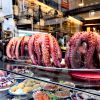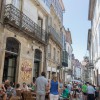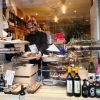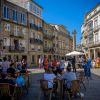- Entra I
- Rexístrate I
- carriño
3. O Franco, delicias mariñas
Raíña conflúe coa rúa do Franco, a súa paralela tanto no mapa como na plena consagración á gastronomía. É unha das rúas máis famosas e turísticas de Compostela. Nela danse cita desde locais tradicionais que acolleron a varias xeracións ata os máis actuais.
A tradición ven de lonxe, cando na Idade Media se asentaron aquí pousadas e tabernas para atender aos peregrinos. Hoxe esa hospitalidade transfórmase en abundancia: as vidreiras son verdadeiras naturezas mortas compostas por marisco, peixes, filetóns, chuletas, chourizos, queixos e verduras. Nos acuarios nada, á vista de quen o queira levar ao prato, un batallón de crustáceos, e nas bandexas pechan filas os moluscos.
Quen é quen neste país do sabor mariño? En Galicia o viaxeiro atopará dous tipos ben diferenciados de marisco: o bo e o insuperábel. Bo é o marisco que cada día chega de Bretaña, Irlanda ou Escocia. Pero para as verdadeiras esencias do mar, todos os expertos recoñecen que non hai no mundo marisco como o galego. Non resulta doado distinguilo, pero hai unha regra infalíbel: o bo marisco nunca é barato. Así encontraremos as mellores lagostas, lumbrigantes, camaróns, lagostinos, centolas, nécoras, percebes, bois de mar e santiaguiños, que compoñen a nómina principal dos crustáceos. Entre os moluscos destacan as ostras, ameixas, berberechos, mexillóns, longueiróns e navallas, vieiras, zamburiñas e coquiñas.
A preparación é sempre sinxela: unha simple cocción en auga con sal para os crustáceos. Lagostas, lumbrigantes e lagostinos tamén se poñen á prancha ou en salpicóns (marisco cocido e picado, con cebola, pirixel, pemento vermello e unha vinagreta con xema de ovo). Os percebes sempre cocidos e ben quentes, levados directamente da pota á mesa. As ameixas preséntanse á mariñeira, ou crúas, o mesmo que as ostras. Longueiróns e navallas son apropiados para a prancha, como as zamburiñas, que tamén poden ir ao forno, como as vieiras, ou en empanada. As empanadas son un mundo aparte, e poden levar dende atún ou bacallau con pasas ata berberechos, sardiñas, carnes, embutidos ou verduras en infinitas combinacións.
Un vello dicir galego asegura que o marisco debe comerse nos meses que teñen ‘r’, que son os que van de setembro a abril. O verán sería entón mal momento para comer marisco de calidade, pero iso no é de todo certo. As vedas son un indicativo do mellor marisco que podemos comer: o verán é tempo de lagosta, lumbrigante, nécora e santiaguiños, así coma percebes e camaróns, que non teñen veda. Por modesto non hai que esquecer o mexillón, primeiro e único produto do mar en toda Europa con denominación de orixe protexida. Galicia é o segundo produtor de mexillón do mundo.
Outro gran omnipresente é o polbo. En Galicia calquera celebración popular que se prece ten polbo ‘á feira’ (con aceite, sal gorda e pemento), que é o estilo propio das terras do interior. Tamén se toma guisado con patacas, típico da zona costeira; á prancha ou en empanada. Iso si, sempre con viño e non con auga, porque unha vella crenza asegura que ‘o polbo e auga non fan bo caldo na barriga’.
O peixe non pode faltar na gastronomía galega, que emprega máis de 80 variedades de mar: pescada, sargo, rodaballo, raia, congro, rape, mero, palometa, salmonetes, sardiñas e xoubas, pintos e maragotas dan fe de que Galicia conta coa flota pesqueira máis grande de España. Se lle ofrecen ‘caldeirada’ saiba que vai comer peixe (dun ou máis tipos) cocido en compañía de patacas, cebola, pementos, aceite e pemento doce. Cando o pida ‘á galega’ comerao cocido, en compañía de patacas cocidas e bañado en allada, que consiste nun bo aceite no que se friten uns allos e despois se agrega pemento doce.
Galicia é tamén de xaneiro a abril o paraíso dos amantes da lamprea. Este estraño peixe –o vertebrado máis antigo do mundo, segundo din, cuns 500 millóns de anos- chega dos ríos Miño e Ulla para ser consumido ‘á bordelesa’, cociñado no seu propio sangue, con viño, especias e hortalizas.




















